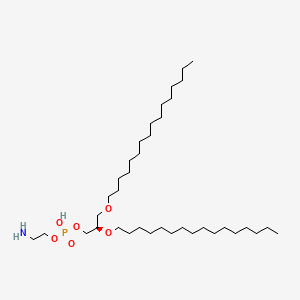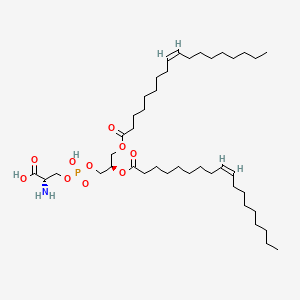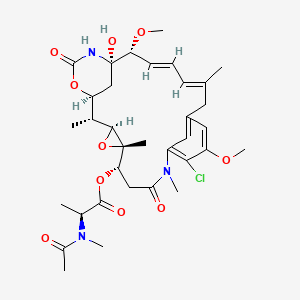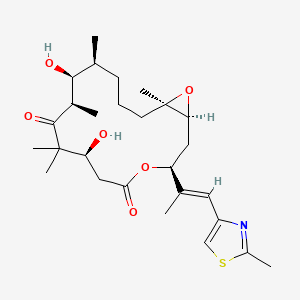
|
61423-61-8 |
61423-61-8 is a lipid of Glycerophospholipids (GP) class. 61423-61-8 is associated with abnormalities such as Superficial ulcer, Spastic syndrome, Morphologically altered structure, Dysentery, Shigella dysenteriae and Cholera. The involved functions are known as Force, vesicle fusion, Physiologic Organization, Drug Interactions and Pressure- physical agent. 61423-61-8 often locates in biological membrane, Tissue membrane, Head, Membrane and Cell membrane. The associated genes with 61423-61-8 are ATR gene, glycyl-glycyl-glycine, Protein Structure, Polypeptides and MCC gene. The related lipids are 1,2-oleoylphosphatidylcholine, proteoliposomes, Sphingolipids, Sterols and DOPE. |
457 |

|
PE(15:0/20:0) |
PE(15:0/20:0) is a lipid of Glycerophospholipids (GP) class. Pe(15:0/20:0) is associated with abnormalities such as Exanthema, Infection, Painful Bladder Syndrome, Obesity and Fatty Liver. The involved functions are known as conjugation, Transcription, Genetic, Sinking, Autophagy and Protein Biosynthesis. Pe(15:0/20:0) often locates in membrane fraction, soluble, Membrane, Body tissue and Tissue membrane. The associated genes with PE(15:0/20:0) are GABARAPL2 gene, ATG10 gene, ATG12 gene, SLC33A1 gene and GABARAP gene. The related lipids are Liposomes, Lipopolysaccharides, Phosphatidylserines, Membrane Lipids and Cardiolipins. The related experimental models are Knock-out and Cancer Model. |
723 |

|
1,2-Dioleoylphosphatidylserine |
1,2-Dioleoylphosphatidylserine is a lipid of Glycerophospholipids (GP) class. The involved functions are known as Process, Membrane Potentials and deprotonation. 1,2-dioleoylphosphatidylserine often locates in I band. The associated genes with 1,2-Dioleoylphosphatidylserine are SCTR gene. The related lipids are 1,2-oleoylphosphatidylcholine, DOPE and 1,2-distearoylphosphatidylethanolamine. |
259 |

|
1-Oleoyl Lysophosphatidic Acid |
1-Oleoyl Lysophosphatidic Acid is a lipid of Glycerophospholipids (GP) class. 1-oleoyl lysophosphatidic acid is associated with abnormalities such as Myocardial Infarction, early pregnancy, Scleroderma, Blind Vision and Hyperlipidemia. The involved functions are known as Agent, Blood coagulation, Selection, Genetic, Analyte and Biological Processes. 1-oleoyl lysophosphatidic acid often locates in Tissue specimen, Body tissue, Blood, Membrane and Skin. The associated genes with 1-Oleoyl Lysophosphatidic Acid are Mucin-16, Peptides, SMAD4 gene, RND1 gene and Polypeptides. The related lipids are lysophosphatidic acid, A(2)C, Lysophospholipids, Fatty Acids and sphingosine 1-phosphate. The related experimental models are Mouse Model, Knock-out, Cancer Model, Xenograft Model and Arthritis, Adjuvant-Induced. |
3463 |

|
lysophosphatidic acid |
lysophosphatidic acid is a lipid of Glycerophospholipids (GP) class. Lysophosphatidic acid is associated with abnormalities such as Atherosclerosis, Alzheimer's Disease, Asthma, Diabetes Mellitus, Non-Insulin-Dependent and Septicemia. The involved functions are known as Inflammation, Chemotaxis, Binding (Molecular Function), Polymerization and Inflammatory Response. Lysophosphatidic acid often locates in Cytoskeleton, Microfilaments, actin cytoskeleton, Extracellular and Structure of germinal center of lymph node. The associated genes with lysophosphatidic acid are TNF gene, MAPK3 gene, RHOA gene, CDC42 gene and ADRBK1 gene. The related lipids are lysophosphatidic acid, Lipopolysaccharides, Lysophosphatidylcholines, Lysophospholipids and Phosphatidic Acid. The related experimental models are Knock-out, Transgenic Model, Rodent Model and Disease model. |
820 |

|
trichostatin A |
Trichostatin is a lipid of Polyketides (PK) class. Trichostatin is associated with abnormalities such as Dentatorubral-Pallidoluysian Atrophy, PARAGANGLIOMAS 3, abnormal fragmented structure, Disintegration (morphologic abnormality) and Hyperostosis, Diffuse Idiopathic Skeletal. The involved functions are known as Acetylation, Cell Differentiation process, histone modification, Gene Silencing and Transcriptional Activation. Trichostatin often locates in CD41a, Hematopoietic System, Chromatin Structure, Blood and Endothelium. The associated genes with Trichostatin are SPI1 gene, CELL Gene, Chromatin, CXCR4 gene and DNMT1 gene. The related lipids are Butyrates, Promega, butyrate, Lipopolysaccharides and Steroids. The related experimental models are Knock-out, Mouse Model, Xenograft Model and Cancer Model. |
5401 |

|
MAYTANSINE |
MAYTANSINE is a lipid of Polyketides (PK) class. Maytansine is associated with abnormalities such as Myelosuppression and BOSLEY-SALIH-ALORAINY SYNDROME. The involved functions are known as Mutation, Agent, Polymerization, Cell Cycle Arrest and Drug Kinetics. Maytansine often locates in Cytoplasm, Hepatic, Lysosomes, Cell surface and Microtubules. The associated genes with MAYTANSINE are ABCB1 gene, HM13 gene, CNN1 gene, CYP2C8 gene and CYP2D6 gene. The related lipids are Valerates. The related experimental models are Xenograft Model. |
984 |

|
Epothilone B |
Epothilone B is a lipid of Polyketides (PK) class. Epothilone b is associated with abnormalities such as Myelosuppression, Measurable Disease, Neuropathy, Neutropenia and Thrombocytopenia. The involved functions are known as Cell Cycle Arrest, Apoptosis, Signal Transduction, Cytokinesis and Caspase Activation. Epothilone b often locates in Mitochondria, Cytoplasmic matrix, Microtubules, Spindle and Protoplasm. The associated genes with Epothilone B are TNFSF10 gene, DIABLO gene, FADD gene, BCL2 gene and BCL2L1 gene. The related lipids are Promega and Phosphatidylserines. The related experimental models are Xenograft Model and Mouse Model. |
492 |

|
nystatin |
nystatin is a lipid of Polyketides (PK) class. Nystatin is associated with abnormalities such as Virus Diseases, Infection, Candidiasis, Leukopenia and Mycoses. The involved functions are known as Membrane Potentials, Uptake, Flow or discharge, Cell membrane potential and adenine transport. Nystatin often locates in Cell Wall, Plasma membrane, Extracellular, Membrane and Virion. The associated genes with nystatin are Genome, Integral Membrane Proteins, Amino Acids, Basic, P4HTM gene and Homologous Gene. The related lipids are Sterols, Liposomes, Membrane Lipids, Sphingolipids and 1,2-oleoylphosphatidylcholine. The related experimental models are Knock-out and Xenograft Model. |
4890 |

|
CYTOCHALASIN B |
CYTOCHALASIN B is a lipid of Polyketides (PK) class. Cytochalasin b is associated with abnormalities such as Renal tubular disorder and Chagas Disease. The involved functions are known as Membrane Protein Traffic, inhibitors, Metabolic Inhibition, Biochemical Pathway and Increased Sensitivy. Cytochalasin b often locates in Cytoplasmic matrix, Plasma membrane, Microtubules, Extracellular and Protoplasm. The associated genes with CYTOCHALASIN B are SLC2A2 gene, PFDN5 gene, SLC2A1 gene, OMG gene and SPEN gene. The related lipids are Steroids, Lipopolysaccharides and Liposomes. The related experimental models are Xenograft Model. |
9648 |









